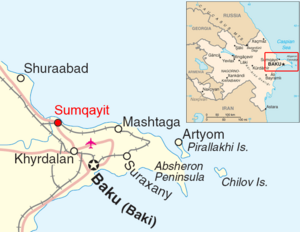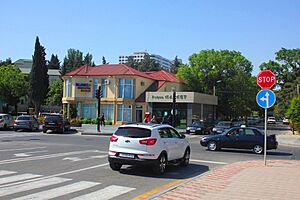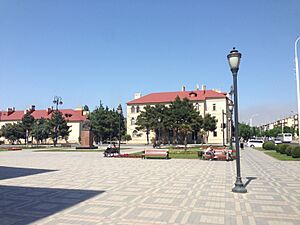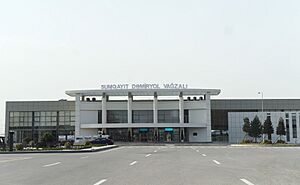Sumgait facts for kids
Quick facts for kids
Sumgait
Sumqayıt
|
||
|---|---|---|
|
City
|
||
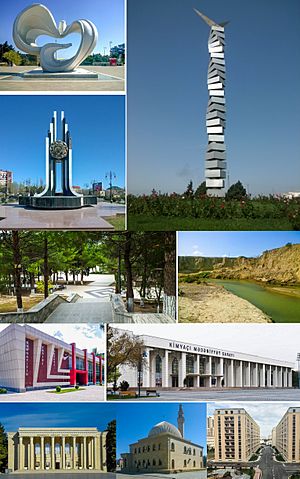 |
||
|
||
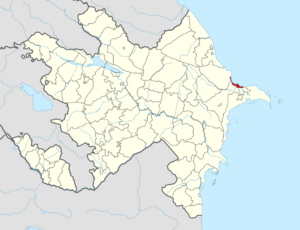 |
||
| Country | ||
| Region | Absheron-Khizi | |
| Founded | 22 November 1949 | |
| Area | ||
| • Total | 90 km2 (30 sq mi) | |
| Elevation | 26 m (85 ft) | |
| Population
(2019)
|
||
| • Total | 491,068 | |
| • Density | 5,460/km2 (14,100/sq mi) | |
| • Population Rank in Azerbaijan | 2nd | |
| Time zone | UTC+4 (AZT) | |
Sumgait is a big city in Azerbaijan, located close to the Caspian Sea. It's on the Absheron Peninsula, about 31 kilometers (19 miles) from the capital city, Baku. In 2019, Sumgait had about 422,600 people, making it the second-largest city in Azerbaijan after Baku.
The city covers an area of 83 square kilometers (32 square miles). It started as a small town near Baku in 1944. On November 22, 1949, it officially became a city. During the time of the Soviet Union, it grew into a major industrial center. The areas of Jorat and Haji Zeynalabdin are also part of Sumgait. It is also home to Sumqayit State University.
Contents
What's in a Name?
The name of Sumgait might come from an old Mongolian tribe called Sugaut (Sagait).
There's also a local story about how the city got its name from the Sumgait River. The legend says a hero named "Sum" fought a monster that was blocking the river. Sum defeated the monster, but the rushing water carried him away, and he was never seen again. His beloved, Jeyran, would go to the river and cry, "Sum qayıt!" This means "Sum, come back!" in Azerbaijani. So, the river became known as Sumgait, and the city was named after it.
A Look at Sumgait's Past
Early History
Historians believe that ancient tribes lived in the Sumgait area a long time ago. During construction work, old items like kitchenware and parts of a caravanserai (a roadside inn for travelers) were found.
The first mentions of settlements in this area were in 1580 by an English traveler, H. Barrow. Later, in 1858, Alexander Dumas wrote about the region in his travel stories. However, the area didn't really develop until the Soviet Union took control in the 1920s.
Soviet Times
During the Soviet era, Sumgait became a big industrial city. However, in the late 1980s, there was a lot of unrest in the Soviet Union.
A sad event happened in Sumgait from February 27-29, 1988. This was a time of violence against the local Armenian people. It was one of the first violent events of the Nagorno-Karabakh conflict. This event led to many people being hurt or having to leave their homes.
Modern Republic Era
After the First Nagorno-Karabakh War, many Azerbaijani people who had to leave their homes came to live in Sumgait. They were mainly from the Qubadli and Zengilan regions. In 1994, Heydar Aliyev, a leader in Azerbaijan, started a big project to create a Free Economic Area in the city.
Sumgait's Location and Weather
Sumgait is located near the Caspian Sea and has a climate with warm summers and mild winters.
Weather in Sumgait
| Climate data for Sumqayit | |||||||||||||
|---|---|---|---|---|---|---|---|---|---|---|---|---|---|
| Month | Jan | Feb | Mar | Apr | May | Jun | Jul | Aug | Sep | Oct | Nov | Dec | Year |
| Mean daily maximum °C (°F) | 6.7 (44.1) |
6.3 (43.3) |
9.8 (49.6) |
17.0 (62.6) |
22.5 (72.5) |
27.6 (81.7) |
30.7 (87.3) |
32.0 (89.6) |
26.0 (78.8) |
19.5 (67.1) |
15.9 (60.6) |
9.3 (48.7) |
18.6 (65.5) |
| Mean daily minimum °C (°F) | 1.3 (34.3) |
1.1 (34.0) |
3.4 (38.1) |
8.6 (47.5) |
13.8 (56.8) |
18.8 (65.8) |
21.7 (71.1) |
21.8 (71.2) |
18.2 (64.8) |
12.5 (54.5) |
10.1 (50.2) |
3.6 (38.5) |
11.2 (52.2) |
| Average precipitation mm (inches) | 24 (0.9) |
20 (0.8) |
23 (0.9) |
40 (1.6) |
36 (1.4) |
31 (1.2) |
14 (0.6) |
14 (0.6) |
21 (0.8) |
33 (1.3) |
32 (1.3) |
25 (1.0) |
313 (12.4) |
| Source: Climate-Data.org | |||||||||||||
Protecting the Environment
Because Sumgait became a big industrial city during the Soviet era, it faced challenges with pollution. After Azerbaijan became independent, many factories slowed down. The Absheron Peninsula, where Sumgait is located, was known for its environmental issues.
However, the city has been working hard to improve its environment. From 2003 to 2010, Sumgait had a special plan to reduce pollution. This plan involved 118 different activities to make the city cleaner. For example, the amount of dirty water from factories has gone down a lot. The World Bank has even helped Azerbaijan with money to build a safe place for mercury waste.
How Sumgait is Governed
The city of Sumgait includes the main city area and the smaller towns of Jorat and Haji Zeynalabdin. The city is led by a mayor, who is currently Zakir Ferejov.
Who Lives in Sumgait?
In 2018, Sumgait had about 341,200 people. This was a big increase from 256,700 people in 2000. About half of the population are men (168,300) and half are women (172,900). More than 23% of the people living in Sumgait are young people and teenagers aged 14–29.
Most of the people in Sumgait are Azerbaijanis, making up 85% of the population. Other groups include Talysh (5%), Lezgins (5%), Russians (2%), and Turkish (1%). Before 1988, about 20,000 Armenians lived in Sumgait, but they had to leave after the events of the Sumgait pogrom.
Religion in Sumgait
For a long time, Sumgait did not have a mosque. After the Soviet Union ended, mosques were built. In recent years, Sumgait has become a place where a certain type of Sunni Islam, called Salafism, is practiced.
Sumgait's Economy and Industry
In 1935, the Soviet government decided to build many factories in the Absheron Peninsula. Sumgait was chosen because it was close to Baku and had good railroad connections.
From 1938 to 1941, a thermal power station was built to provide electricity for Baku's growing oil industry. More heavy industries followed. Construction stopped during World War II but started again in 1944. That's when metallurgical (metal-making) and chemical plants were built. The first products from the Sumgait Chemical Plant led to fast growth and new jobs. In 1949, Sumgait officially became a city.
Over the years, many more factories were built. These included a tube-making plant, a synthetic rubber plant, and plants for processing steel and aluminum. In the 1960s, a very large petroleum chemical factory was built. By the end of the 1980s, Sumgait was a major center for the chemical industry in the Soviet Union.
After the dissolution of the Soviet Union, Sumgait remained Azerbaijan's second-largest industrial city. Many important companies operate here, like Azerpipe and Azeraluminium.
In 2011, new projects like the Sumgait Technologies Park (STP) and Sumgayit Chemical Industrial Park (SCIP) began. These parks aim to attract new businesses, including those in pharmaceuticals, construction, and electronics. They are designed to be self-sufficient, with homes, labs, and schools.
Culture and Fun in Sumgait
City Design and Buildings
The first studies on how to design and plan the city of Sumgait were done by Kamal Mammadbeyov. He was an Azerbaijani and Soviet scientist and an honored architect. He wrote many scientific papers and a book about Sumgait's architecture. The Flag Museum in Sumgait opened on December 15, 2017.
Music and Media
Sumgait was a very important place for rock bands in the 1990s. Bands like Yuxu, Miraj, Mozalan, and Sirr came from here.
The city has its own local TV channel called Dünya TV and a newspaper called 365 Gün. In 2020, the Azerbaijan Jewish Media Center was also started in Sumgait.
Parks and Green Spaces
During the Soviet era, Sumgait was thought to have the longest boulevard in Azerbaijan. The Culture and Leisure Park was built along 23 hectares (57 acres) of the Sumgait coastline in 1967. In 1978, the park was named after the famous Azerbaijani poet Imadaddin Nasimi. That same year, the city put up the Peace Dove sculpture in the park, making it a symbol of peace for the city.
The park has 39 different types of trees. Later, monuments like Stars (Ulduzlar) and 20 January Monument were added to remember important events. In one part of the park, called Shehidler Khiyabani, there is a burial ground for soldiers from Sumgait who died in the war. This is similar to Martyrs' Lane in Baku. The park is now 80 hectares (200 acres) big and is considered historically important.
Besides Nasimi Park, Sumgait also has Ludwigshafen Park, built in 1997 to celebrate the city's friendship with Ludwigshafen in Germany. Heydar Aliyev Park and Luna Park were also built in 1999.
Sports in Sumgait
Sumgait has a professional football team called Sumgayit FK. They play in the top football league in Azerbaijan, the Azerbaijan Premier League.
Getting Around Sumgait
Sumgait used to have a tram system from 1959 to 2003. It also had a trolleybus system with eight lines, which operated until 2006.
On June 3, 2015, the reconstructed Baku-Sumgait Railway was opened. Now, trains can travel from Baku to Sumgait in about 40 minutes, making travel easier for people.
Learning in Sumgait
As of 2011, Sumgait had 49 schools, 13 vocational and music schools, a private Turkish high school, and a teachers' institute.
The main university in the city is Sumqayit State University. It has seven departments and about 4000 students.
Famous People from Sumgait
Many notable people come from Sumgait, including:
- Chess players
- Shakhriyar Mamedyarov
- Turkan Mamedyarova
- Zeinab Mamedyarova
- Balaban player
- Alihan Samedov
- Footballers
- Kamal Guliyev
- Ruslan Safarov
- Mahir Shukurov
- Nazim Suleymanov
- Judo
- Ilham Zakiyev
- Karateka
- Rafael Aghayev
- Mixed martial arts (MMA) fighters
- Tural Rahimov
- Politics
- Emin Huseynov
- Religion
- Archbishop Pargev Martirosyan
Sister Cities
Sumgait is connected with other cities around the world as "sister cities":
 Rustavi, Georgia, (since 1952)
Rustavi, Georgia, (since 1952) Cherkasy, Ukraine, (since 1972)
Cherkasy, Ukraine, (since 1972) Pitești, Romania, (since 1971)
Pitești, Romania, (since 1971) Ludwigshafen, Germany, (since 1977)
Ludwigshafen, Germany, (since 1977) Bari, Italy, (since 2004)
Bari, Italy, (since 2004) Aktau, Kazakhstan, (since 2009)
Aktau, Kazakhstan, (since 2009) Mogilev, Belarus, (since 2009)
Mogilev, Belarus, (since 2009) Nevinnomyssk, Russia, (since 2011)
Nevinnomyssk, Russia, (since 2011) Genoa, Italy, (since 2013)
Genoa, Italy, (since 2013) Zhuzhou, China
Zhuzhou, China Ceyhan, Turkey
Ceyhan, Turkey
See also
 In Spanish: Sumqayıt para niños
In Spanish: Sumqayıt para niños




